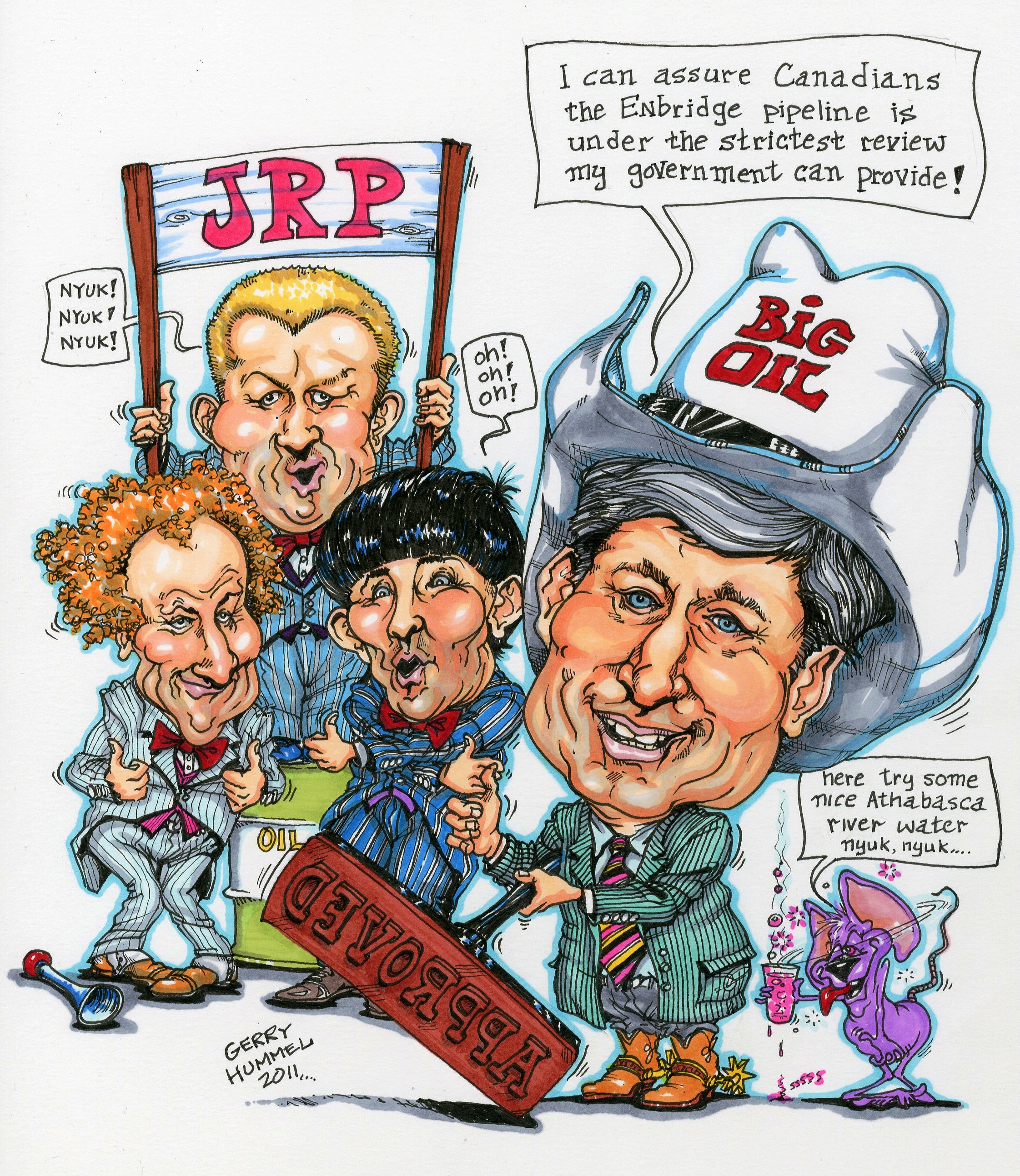Read this article from the Globe and Mail on the growing momentum for a national energy strategy, a concept the Harper Conservatives are now mulling out loud, in contrast to their traditional opposition to the idea. (July 10, 2011)
Tag Archives: BC Oil Pipelines and Supertankers

Gerry Hummel Cartoon: Enbridge Rubber Stamp Panel
The latest cartoon from Gerry Hummel – referencing the Joint Panel Review for the hugely controversial proposed Enbridge Northern Gateway Pipeline. Rules defining public participation were recently announced by the Canadian Environmental Assessment Agency and National Energy Board. Despite assurances of multiple avenues for public comment, many First Nations, citizens and conservation groups from the region are expressing their doubts – remaining in steadfast opposition to the project.


A-G Report Confirms BC’s Sham Environmental Assessment, Enforcement
Vindication always feels good but as you read the Auditor-General’s report on the BC Environmental Assessment Office (BCEAO), which reports to the Ministry of Environment – it’s the government’s licensing and enforcement arm – the warm feeling of vindication quickly vanishes and you are swamped with the realization of what this government’s gross neglect has done and continues to do to our province.
National Geographic Photo Essay on Great Bear Rainforest, Enbridge
Check out this photo essay featuring aerial photography of the Great Bear Rainforest from National Geographic. (June 7)
AFP international news video story on Enbridge pipeline – feat. images by Damien Gillis, Ian McAllister
Watch this 3 min video news story from international agency AFP on the proposed Enbridge Northern Gateway Pipeline and the Tar Sands – featuring images by Damien Gillis and Ian McAllister. (July 5, 2011)
Transport Safety Board logged 100 oil pipeline accidents or ‘incidents’ in last 2 years – led by Enbridge, TransCanada
Read this important story from the Vancouver Sun on new details of staggering number of oil pipeline accidents and incidents logged by the Transportation Safety Board of Canada – three quarters of them stemming from Enbridge or TransCanada Pipelines. (July 5)
Kinder-Morgan Vancouver Pipeline and Tankers Slipping in Through Back Door – Sun Op-ed
Read this important op-ed in the Vancouver Sun by Ecojustice’s Karen Campbell on the sneaky Kinder-Morgan pipeline expansion and planned increase of oil tankers through Vancouver – June 27, 2011

Why the Precautionary Principle Should but Doesn’t Apply in BC
There is a reason that we who want to save our environment are losing the war and may lose it outright unless we gird up our loins and fight to the death, politically speaking.
The reason is simple: no government set in authority over us will apply the “Precautionary Principle” (despite Canada’s international commitment to uphold it) to undertakings in the environment and thus they permit despoilers to get away with, literally, murder.
Here is the principle as generally stated. “The precautionary principle …states that if an action or policy has a suspected risk of causing harm to the public or to the environment, in the absence of scientific consensus that the action or policy is harmful, the burden of proof that it is not harmful falls on those taking the action.”
This is what this means to British Columbians – the Precautionary Principle prevails, or rather should prevail, in the following cases: Fish farming, power projects, threats to the atmosphere, pipelines and tanker traffic. It also should apply, in my opinion, to highway and bridge construction.
In fact, in each of the above cases the onus has rested not on the potential despoiler but on the general public. This turnabout provides the despoiler with a one line defence which runs, “You don’t really believe that crap do you?” That becomes an effective reply to the strongest scientific argument – it’s really a thinly disguised “Big Lie” technique.
Let’s look at how this has been applied.
For over a decade the persistent and courageous Alexandra Morton has led a scientific investigation into the adverse – to put it mildly – impact of sea lice from fish farms on migrating wild salmon. Her studies have been peer-reviewed (that is to say reviewed by other scientists and published in recognized scientific journals) by virtually every scientist in the world who deals in this area. Moreover many fish biologists have carried out their own peer reviewed studies which have concluded, as Ms. Morton has, that the impact from sea lice from fish farms is enormously destructive.
What have industry and the government done?
Through discredited former environmentalists like Patrick Moore and industry flacks like Mary Ellen Walling they’ve simply denied the findings and distorted the evidence hoping, and often succeeding, to be able to ask the public, “You don’t really believe that crap do you?”…”Would you deny British Columbians jobs because of unproved charges by some so-called scientist?”
NOT BEING REQUIRED TO DEMONSTRATE THE SAFETY OF WHAT THEY DO, THEY ARE ABLE TO SIT BACK AND RAISE DOUBTS ON NO EVIDENCE WHATSOEVER!
The ad hominem attack on a scientist by an industry or, sadly, government flack counts for more than properly researched science. Thus has the proper method of determining environmental safety been subverted to high priced PR flackery.
Thus the silly but effective question, “You don’t really believe that crap?” trumps science.
This industry/government defence has a slightly different twist when it comes to the private/public power debate. Here the government – wonders never cease – actually admits that some environmental harm could come from gutting rivers, diverting the water with dams and clear-cutting for roads and transmission lines; so they convene environmental hearings and in doing so don’t follow the “precautionary principle” – heaven forefend! – but the political principle which states simply, “Never hold a hearing unless you know what the result will be.” Consequently these hearings are convened by the company in a location least likely to be conducive to large crowds and the government fixes the result by making it out of order to ask any questions about the desirability of the scheme in the first place!
In short, by the time the public has a say, it’s a done deal and the only issue left is the terms of reference for the “scientific” investigation by – hold your breath now – the government that has already approved the deal in principle, and the “environmental department” and paid consultants of the company!
When Dr. John Calvert, Dr. Marvin Shaffer, noted scientists, economist Erik Andersen, environmentalists Joe Foy, Gwen Barlee, Damien Gillis or Rafe Mair lay before the public the facts on how the Liberals destroy the environment to make power BC Hydro must buy at a huge loss, putting BC Hydro in mortal peril, the company and government need only ask, “Do you believe that crap from those environmental maniacs?” – and the job is done.
With pipelines and oil tankers the story takes a slightly different tack. There have been so many spills and ruptures that neither government nor industry can deny that they happen – they would like to but even their PR flacks have some credibility limitations. The propositions put forward by the companies and their hired governments are even more breathtaking for they say that the risks are “reasonable” or “slight” or “manageable” – and outweighed by the stated (and grossly exaggerated) benefits.
Think on that for a second and several facts pop up. For one, if you are going to do something forever with no limitations on how often or how long you will do it, a spill or a leak is no longer a risk but a certainty waiting to happen.
Then comes the inevitable conclusion: when it happens it will be devastating! Every oil spill or leak is!
Thus the emollient offerings by company and government are met by the certainty that their project will be a major catastrophe, yet the cries of those who know that a catastrophe will certainly occur are drowned out by the cry, “Do you believe that crap from those people who don’t want any ‘progress’ and who hate industry?”
The absolute certainty of environmental catastrophe is met by bought-and-paid-for government and industry flacks who pour it on with the basic theme that “life is risky; we must take risks to develop and grow and create jobs and are you going to listen to that shit from eco-freaks like Rex Weyler?”
Let me ask of you this question: who of you, after the disaster, will agree it was a “risk” worth taking, especially when you’ve known in your tummy all along that it was no risk but a dead certainty?
The matter must be fairly stated – development in this province is done by corporations who don’t give a fiddler’s fart for the environment, and why should they? Their obligation is to make money for their shareholders, so why would we expect them to care? If they did care they would be in breach of their shareholders’ trust.
This industry finances the Liberal and Conservative governments – make no mistake on that account. Those governments have an obligation to repay that debt and can be counted upon to do so.
There is an interesting sidelight to all this. Opponents to the Liberal government either have a history – or have been painted as having a history of incompetence. That’s the rap and the Liberals play it like a finely tuned Stradivarius.
Is that to say that the government that has privatized BC Rail, forced BC Hydro to the brink of bankruptcy, run up huge deficits and nearly doubled the provincial debt while turning over our outdoors to large, mostly foreign corporations is to be seen as competent? A government that lies about its budget, the HST and destroys our environment is a good government?
I had plenty to say about the NDP governments in their 1991-2001 decade and very little of it complimentary. But compared to this Liberal bunch they were paragons of fiscal probity. Whatever index you like – corporate profits, economic growth, provincial debts and contributing deficits, employment – you name it – the NDP are clear winners and you only need read what the far right wing Canadian Taxpayers Federation has to say for the proof.
We, the people of British Columbia must, in my view, ponder the consequences of more of the same from this Liberal government: ruined rivers and streams, tar sands bitumen spilled on our virgin lands and in our oceans, our soul – the Pacific Salmon – destroyed, our coveted power company ransacked by private and mostly foreign corporations, our farmland and sensitive habitat ravaged; a government that promises more of the same and defends itself only by defaming those who are critical of it. A government that had to change the law to avoid balancing its books.
If you stop and examine the Liberal’s rationale for its uncaring attitude towards the environment, it fails and fails badly in economic terms. Their policies not only are ruinous to our environment, but they provide virtually no permanent jobs, bring little, if any, revenue into the provincial coffers and leave behind damage that will be with us forever.
Fish farms don’t produce jobs, only a handful of caretakers. The same applies to private power corporations after short term construction; pipelines and oil tankers not only don’t provide jobs, their profits go out of province. In short, the vaunted Liberal talent for enhancing the economy doesn’t do that – it enhances Alberta’s revenues and those of the huge corporations whose ads tell us how much they care, while leaving permanent destruction for us who live in its path.
All elections are crap shoots and all politicians disappoint. We are, however, looking at an opposition that has a much strengthened and experienced front bench; it is an opposition that has put a great deal of its political cant behind it while retaining what I see as critical sensitivity to our traditions and the legacy we leave; it is also an opposition that has learned bitter lessons from its past.
It is possible to have social sensitivity and prosperity – in fact the latter, if it’s to last, must have the former. That the NDP have learned that destruction of our environment doesn’t bring prosperity is surely a plus.
Looking at the choice that faces us I can see no sensible alternative to throwing out the Liberals – and the sooner, the better.
Forbes.com: China vs. USA for Canadian oil resources
Read this article from Forbes.com on the growing conflict between China and the US over Canadian oil resources – June 25, 2011

Boo Hoo for Big Oil: Tar Sands Promoters Lament Tough Opposition
There’s nothing quite so pathetic as the richest industry in history feeling sorry for itself – and there’s been a lot of that going on lately. Under the strain of coordinated opposition to the expansion of Alberta’s Tar Sands on multiple fronts, Big Oil and its government cheerleaders is increasingly sounding like a bunch of sniveling crybabies – complaining amongst themselves and to the public of being unfairly out-messaged by radical tree-huggers or, alternately, well-funded non-profit groups.
At a recent Tar Sands strategy session – titled “Oilsands: What’s Really Going On” – hosted in Edmonton by the Canadian Association of Petroleum Producers (CAPP) and the Edmonton Economic Development Corp., Alberta Energy Minister Ron Liepert blamed “environmental extremists” for unfairly plugging up the free flow of Alberta bitumen, threatening the future expansion of the industry. “We cannot stand by and let commerce and job creation become secondary to the sensational images used by environmental groups to solicit emotional responses, especially because those images do not portray the reality of our industry,” Liepert implored his audience. Kind of makes you feel sorry for those poor, misunderstood oilmen, now doesn’t it?
Apparently, the efforts of aboriginal and environmental groups, photographers and filmmakers, and diverse citizens opposing key pipelines in Canada and the US are having some effect. Judging by the pep talks flying around industry gatherings and the op-ed pages of conservative media outlets, the industry is seriously worried about the Tar Sands’ future. Even a recent article in the industry publication Alberta Oil Magazine about several major proposed pipeline routes from the Tar Sands (more on these in a moment) refers to them as “radically different but equally controversial.”
What’s at stake is three (potentially four) major new pipelines or expansions designed to amp up the export capacity for the Tar Sands to both the US and Asia. Together they could justify a doubling of total Tar Sands output.
- Enbridge’s Northern Gateway Pipeline from Bruderheim, Alberta to Kitimat on BC’s North Coast (525,000 barrels/day)
- TransCanada Corp.’s Keystone XL Pipeline from Hadistry, Alberta to refineries in Illinois, Oklahoma and the Gulf Coast (would add 510,000 barrels/day to existing Keystone Pipeline)
- Kinder-Morgan’s Trans-Mountain Pipeline from Alberta to the Westridge Terminal in the Burrard Inlet in Burnaby, BC (would raise existing line from 300,000 to 700,000 barrels/day)
- Recent documents show Kinder-Morgan is considering a spur splitting off its Trans-Mountain Pipeline east of Prince George, heading to Kitimat – which could become the default if the Enbridge line doesn’t go through. (450,000 barrels/day)
The latter is becoming a more realistic prospect as Enbridge faces increasingly fierce opposition to its Northern Gateway Project. And the company isn’t doing itself any favours – with three major pipeline leaks in the US last year and a recent one in the Northwest Territories (on top of the dozens of smaller leaks it averages every year). But it’s the First Nations opposition to the project that presents its greatest challenge – one that may well prove insurmountable. Over 60 nations have lined up together against the Northern Gateway – many of them situated along the pipeline or tanker corridor, thus holding considerable constitutional and legal power over the project through their ancestral title and rights.
TransCanada is also facing an uphill battle for its Keystone XL expansion to refineries in the US. The 590,000 barrel/day existing Keystone line is currently shut down under presidential order, following a pair of recent leaks in North Dakota and Kansas. The associate pipeline safety administrator with the U.S.
Department of Transportation, Jeffrey
Wiese, recently wrote to TransCanada
executives: “After evaluating the foregoing preliminary findings of fact, I find
that the continued operation of the pipeline without corrective action
would be hazardous to life, property and the environment.”
These troubles couldn’t come at a worse time for TransCanada, as they are in the midst of seeking approval from regulators to build the expansion Keystone XL line. The Environmental Protection Agency has been highly critical of the proposal to the US State Department, which is charged with making the final decision on the project. According to a recent article in the Globe and Mail, “For the oil patch, the possibility that the XL project will falter is so
outside expectations that many haven’t even considered it. Indeed,
companies have already signed up for the majority of its capacity.” And yet, to the industry’s incredulous horror, failure is now a distinct possibility for the Keystone XL.
Campaigners, industry and media have started discussing the battle over these pipelines in terms of “choke points”. The idea is that Tar Sands expansion could be curbed indirectly by choking off its avenues for growth – and it has real strategic merit, enough to cause the industry to lose some sleep. Without these new corridors to move diluted bitumen, Tar Sands expansion is unnecessary, as the Financial Post remarked recently in a piece about the “Oilsands: What’s Really Going On” conference in Edmonton.
Andrew Leach, environmental economist and assistant professor at the University of Alberta School of Business, said Alberta faces a future bottleneck as oilsands production is forecast to ramp up while North American consumption wanes. “There’s not enough domestic demand to soak up what the production potential is and not enough pipeline capacity to move it, so you’ll be running up against a wall pretty quickly in the next eight or 10 years,” Leach said.
This is because the real growth in demand for Alberta bitumen lies not in North America, where economic conditions have seen oil demand plateau, but in new markets in Asia – which would be difficult to access without new supply lines carved through BC.
Alberta’s energy minister is far from the only one whining about the rough ride the Tar Sands are getting of late. Premier Ed Stelmach shot back angrily at a provocative billboard campaign in the US last year, which asked Americans to cancel their Banff vacations in protest of the Tar Sands. Stelmach responded with a series of his own taxpayer-funded ads south of the border, bearing the rebuttal: “A good neighbour lends you a cup of sugar. A great neighbour supplies you with 1.4 million barrels of oil per day.” Consider yourself told, America.
Industry nabobs have also been busy rallying the troops and doing their version of image control. Most notable has been the multi-million dollar PR campaign by the industry’s official lobby, CAPP. You know, the one with the happy employees extolling the improvements of an industry recently found to produce (surprise!) among the dirtiest oil in the world.
Then there’s Christy Clark’s advisor and former Encana CEO Gwyn Morgan. In an op-ed published in September of last year in a number of Alberta papers, Morgan wrote:
Environmental zealots are pulling out all the stops to promote a U.S. ban on fuel made from oil sands crude…One thing I learned from my many years as a CEO is that corporations must ensure what they say will stand up as the truth in the face of intense scrutiny, while the innuendo and deliberate distortions of their critics are seldom questioned. But I also learned that you don’t win games back on your heels playing defence. Industry leaders need do more than sitting behind the blue line trying to block shots. They need to take their oil sands story and skate hard up the ice.
Morgan’s message wasn’t directed at the general public. This is the godfather of the Canadian fossil fuels industry sending out the bat signal from his humble $7.5 million abode in Saanich, BC – admonishing his lieutenants and successors for not doing a better job protecting the industry’s image.
Finally, there’s Enbridge CEO Pat Daniel, who addressed a gathering at the Empire Club in Toronto in the lead-up to our recent federal election – urging his fellow captains of industry to get behind the Harper campaign and the oil patch, lest they face a set-back from a Tory loss or another minority government.
According to the Canadian Press, in his speech, “Daniel criticized ‘hard-line’ activists for being hypocritical in ‘saying no’ to the project outright while accepting the benefits that oil brings — ranging from heating their homes to bringing fresh produce to supermarkets.”
Daniel would write an op-ed several weeks later, dismissing voters’ concerns with the Tar Sands and his company’s proposed bitumen pipeline to Kitimat: “Opponents of energy development go so far as to suggest that Canada should be ashamed of our country’s abundant energy resources – the oilsands, in particular. I think this is nonsense. Canada is a leader in the world energy industry in safety, reliability, environmental performance, respect for human rights, regulatory oversight and technological innovation.”
In this time of unprecedented challenge, all the Tar Sands players appear to be reading from the same PR script – particularly several key talking points:
- Play up First Nations interest in pipelines and tankers (even, and especially, when it’s not actually there)
- Exaggerate job benefits, while downplaying the risks and economic impacts of a spill (Enbridge is particularly good at this one, considering all the high-profile spills it keeps racking up and the paltry jobs it would actually yield in BC)
- Dismiss opposition as one of two (seemingly mutually exclusive) things: a) incredibly well-funded environmental foundations who’ve turned opposing the Tar Sands into a lucrative mercenary industry unto itself; b) nothing more than a handful of crazy, socialist, tree-hugging “extremists” (of course, leaving out the part about 80% of British Columbians being in favour of a coastal oil tanker ban).
In other words, call it everything except that which it is: a well-organized, yet organic movement comprised of a broad cross-section of society – everyone from wilderness tourism operators, community groups and citizens to provincial and international environmental organizations and, most importantly, a coalition of over 60 different First Nations. It’s a campaign based on creativity, culture, and a deep concern for the future of this precious province and coastline – not to mention the local and global eco-footprint of the Tar Sands. It’s British Columbians (and Americans, now, with the opposition to the Keystone XL proposal) realizing they have a role to play – and an unprecedented opportunity – in crimping the growth of the Tar Sands. Call them “choke points” if you like – whatever it is, it’s damned inconvenient for an industry used to getting its way.
As Alberta’s energy minister told the “Oilsands: What’s Really Going On” conference, “If we don’t get moving on these projects, our greatest risk in Alberta is that by 2020 we will be landlocked in bitumen.”
Perish the thought.
